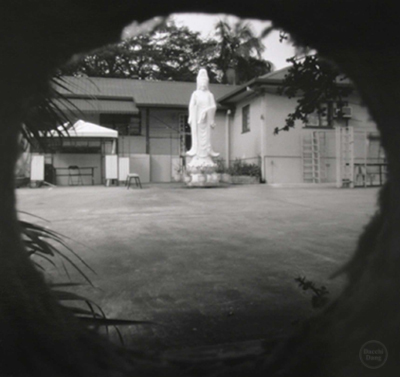Poetics of Light

Dr. Dacchi Dang
Since 2008, my artistic practice has been an exploration and investigation of cultural identity, experience and memories through a practical experimentation utilising the pinhole camera. My personal experience as a post-war Australian Chinese-Vietnamese refugee generates difference, with the question of otherness, diaspora, dislocation, displacement and liminality continually circulating around the tension of belonging, yearning and memory. This sense of difference informs how I use the pinhole camera and inspires multiple perspectives associated with the geographic, political and social landscapes of Australia and Vietnam.
The pinhole has played a prominent role in the history of Western culture. Artists, philosophers and scientists including Brunelleschi, da Vinci, Dürer, Raphael, Kepler, Newton, and Déscartes employed the pinhole as the starting point for some of their theories: crucially, the theory of fixed-eye point or single-point perspective described as a structured reality that holds our entire visual world together[1]. While many Western artists since the Renaissance have represented the world with a central or single-point perspective and focus on salient objects in a scene, their Eastern counterparts have concentrated on context information with multiple perspectives reading from Heaven to Earth in their paintings.
Increasingly, pioneering artists – da Vinci, Monet, Cezanne and Picasso – sought to challenge single-point perspective in 2D works, particularly from the mid-nineteenth century onwards. Contemporary artists have attempted to abandon the theory of single point perspective offered by the camera lens, “to reinvestigate the altering, destruction, or natural evolvement of one-point perspective, thereby creating another visual structure,”[2] as articulated by David Hockney in his endeavour to redefine space.
As pinhole photography is more about the experimentation involved in the process it permits certain freedoms in comparison with other image-making photographic approaches. Because its process embodies chance, pinhole photography is similar to the way many of us live our lives. As a result, this method of experimental photography presents the most interesting and creative modifications for low-cost film cameras, manual printing techniques and unconventional use of the medium. Photographers who successfully operate and create resolved images virtually master a knowledge of optics: the understanding of the interplay of light is a fundamental element for photographers in their visual creativity. Apart from placing the pinhole camera in a certain space or location and dictating the nature of the hole filtering the light, the user has little control over how light and emulsion interact with each other. Even if the camera is placed in the exact same position, at the exact time of day and using the exact same material, each resultant single image will be different. This difference runs the full spectrum, from subtle to substantial, to a point where what has been captured does not seem to bear any meaningful resemblance to other images.
A great deal of understanding about other cultures derives from our comprehension of visual language and capacity to recognise and interpret our relationship to space and time. The extent to which aspects of our inhabited space can be apprehended also depends on time: like an f-stop in the camera aperture, the wider your vision is open to the outside world the more you are able to take in. Like the flattened depth of field of the pinhole camera, there may be some confusion or incomprehension between new and old. By taking these observations in slowly and by not opening completely, you are better able to analyse the information in order not only to more clearly ascertain the difference between the old and new, but also to keep your vision open in the search for new information as you explore these temporal spaces. While other types of cameras are both equally important and valuable to my practice and conceptual concerns, the use of the ‘dot’ or pinprick of light in my pinhole camera is more capable of revealing these complex realities of the liminal space that Vietnamese refugees face in relation to their negotiation of diaspora identity and of home. My dot is not only a mark, it is also reference a point: a point in time, a point of departure or arrival, a point of dislocation and relocation, and a point of view or a fixed point of single perspective.


Dacchi Dang, Fish of the Day from Full Circle series, 2009. Dacchi Dang, Morning Light on Biota Street from Full Circle series, 2009


Dacchi Dang, Old Rock, 2009. Dacchi Dang, Landscape, 2009

Dacchi Dang, Woman Hut, 2009
Feature image: Dacchi Dang, Faith from the Full Circle series, 2009
[1] Eric Renner,1995, Pinhole Photography, ibid., p. ix
[2] Eric Renner, 1995, ibid., pp.157-158 dacchi-dang

Dr. Dacchi Dang is a Sydney-based photographic artist and independent researcher, specialising in alternative photographic processes.
4A Digital is a platform for creative and academic exploration, giving artists, writers, academics and professionals the opportunity to experiment and investigate concepts and ideas outside of the exhibition and published journal formats.

